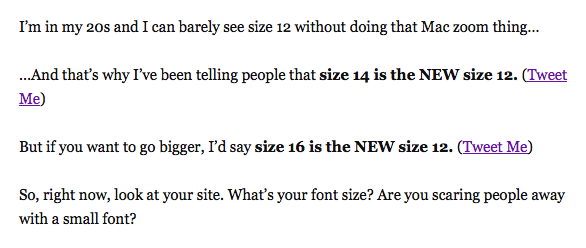It hurts when a post you labored over doesn’t get any comments.
And it stings when no one shares your content on Facebook or Twitter.
But it really feels like a punch to the gut when your ideas don’t go anywhere, doesn’t it?
After all, most of us became bloggers because we had ideas we wanted to spread.
Important ideas. Life-changing ideas. Hell, even world-changing ideas.
But if your ideas aren’t spreading, does that mean you’re failing as a blogger? Is it time to give up?
Before you go off and have a pity party, let’s ask ourselves why your ideas haven’t taken off.
Maybe you haven’t found your voice yet. Maybe your niche is just too crowded. Maybe you’re looking for inspiration in the wrong places.
Or maybe you know how to come up with interesting ideas, but you’re not so good at promoting them. Or you genuinely have a brilliant new take on the world, but you fail when “selling” it to others.
If this describes you, do not despair. You’re not alone. And there is an answer.
But first, let’s pinpoint what’s holding you back.
How Thinking like a Blogger Sabotages the Spread of Your Ideas
When you learned how to start a blog, you began expressing your ideas in the form of blog posts.
Novelists write novels. Poets write poems. Bloggers write blog posts.
The medium dictates the nature of the message.
So if you want your ideas to spread, you simply need people to read – and share – your blog posts.
But you know most people won’t read a whole blog post right off the bat. Because in the real world, people are busy and bombarded with information every minute of every day.
So you’ve learned to craft the perfect headline. The headline sells the post – the post sells the ideas.
But no matter how great your headline is, most people who see it will not click on it. They can spare the one or two seconds required to read your expertly crafted promise, but that’s all you’re getting without a little more substance.
As a result, the key ideas of your post – the ideas that could change someone’s life, or at least change their day – lose their chance to shine. They don’t even see the light of day.
If only you had a quicker, slicker way to spread your ideas. A way that actually led to more traffic for your blog posts too.
Well my friend, you do. And it’s called the tweetable quote.
Tweetable Quotes – the Crack Cocaine of Social Sharing
What exactly are tweetable quotes?
Tweetable quotes are short, catchy messages embedded in a blog post that can easily be shared on Twitter.
They are ideas yearning to be shared. They are action and inspiration in one tidy package. They are witty or profound quotes which embody much larger concepts or whole new frameworks of thinking.
And when people share your quotes, they spread your ideas and drive traffic back to your blog by the boatload.
Why can tweetable quotes help your ideas spread further than typical “here’s a link to my post” tweets?
Let’s look at the reasons:
- By including one or more quotes in your post, you are giving the reader multiple opportunities, and multiple reasons, to share your content.
- Since tweetable quotes include an explicit call to action (e.g., “tweet this”) in context, they stand out in comparison to the social sharing widgets hovering on the periphery.
- Prompting readers to share a quote (not a post) capitalizes on many readers’ preference for sharing ideas over personalities. They’re not seen as promoting a person, just an idea.
- Because tweetable quotes have self-contained value (they are a piece of wisdom in themselves), readers are more inclined to share them, even if they don’t have time to read the entire post.
Now, bloggers didn’t invent memorable quotes, any more than they invented writing. But bloggers can use quotes to spread their ideas far and wide.
How Big-Name Bloggers Are Using Tweetable Quotes
It’s no wonder big-name bloggers are embracing tweetable quotes. Take, for example, Derek Halpern of Social Triggers. Tweetable quotes are one of the tools that Derek has used to turn his little marketing blog into a powerhouse.
Back in 2011, before Social Triggers had the large following it does today, Derek published a post called “What’s the Best Font For Your Site?“
Ugh … sounds boring, right? That post could have been easily forgotten, except for two things.
First of all, Derek tends to punch boring in the face.
Secondly, Derek inserted two short, tweetable quotes based on his own comments about font size inside the post.
They looked like this:
The result? That one post generated around 9,000 hits in a few weeks. It helped put Social Triggers on the map.
Another popular blogger who has used tweetable quotes successfully is author and blogger Jonathan Fields. The creator of the Good Life Project, Fields used a tweetable quote in his post “Hoping Others Fail is not a Strategy“:
Fields included that single quote in the post when he published it on September 30th, 2013 and it was shared more than 60 times on Twitter.
A tweetable quote “can serve as a catalyst for sharing, but you need to craft a social-currency worthy sound bite,” says Fields. It’s “a short phrase that both resonates on a personal level and inspires sharing with the desire to both create value and get credit for finding something cool.”
Now let’s break down how you can create these quotes.
How to Create Finely-Tuned Sound Bites That Make Your Ideas Go Viral
Why do tweetable quotes help your ideas spread faster?
Well-written quotes both convey meaning and do so in a clever, memorable, or creative way.
Unlike a headline, which needs to capture the essence of an entire post, a quote needs only convey a discrete idea. Readers for whom the idea resonates may be salivating at the chance to share it with others.
But you can’t just pluck quotes from your post and hope for the best. You need to spend time to mold your ideas and refine them, much like we did in creating this post.
A good tweetable quote is much more like a sound bite – a short phrase or sentence that captures the essence of a speaker’s speech, talk, presentation, or other message.
Halpern, for instance, says tweetable quotes that are structured like sound bites are more likely to be shared because they are “easy to recognize, … easy to remember, easy-to-share, and they stand out in the sea of words found online.”
In other words, a quote offers a greater opportunity for creativity and uniqueness than a headline.
And using certain principles or patterns will make these quotes much easier to create, and greatly increase your chances that they will go viral.
In fact, you can use a “bible” that will show you the secrets to articulating ideas that stick – and spread.
The 5 Proven Secrets to Crafting Quotes that Spread Like Crazy
To make your tweetable quotes spread like wildfire, you need to understand what makes ideas spread.
Just as Jon’s Headline Hacks is the definitive guide for crafting headlines that go viral, the definitive guide for how to create ideas that go viral is the book Made to Stick by Chip and Dan Heath.
In Made to Stick, the Heath brothers analyze why some ideas thrive while others die. The authors looked at ideas from urban legends, tall tales, speeches, movies, pop culture, and other areas in analyzing what common features led to certain ideas thriving, and other ideas landing with a thud.
Although the book was written to describe the transmission of ideas rather than discrete quotes, the Made to Stick principles apply perfectly to tweetable quotes.
Ready? Let’s do this.
1. Keep It Simple, Stupid
One of the core principles in Made to Stick is to keep your ideas simple. To make an idea resonate with a wide audience, you must strip away all extraneous material, making the idea both simple and profound. As the Heath brothers wrote, finding the core of an idea “means stripping an idea down to its most critical essence.”
One of the most famous sound bites of recent years emerged from the O.J. Simpson trial. In his closing argument, defense attorney Johnnie Cochran used the simple phrase, “If the glove don’t fit, you must acquit.”
This resonated because it stripped down the ideas of the trial to their bare essence. The message was simple and profound, and it ignored volumes of evidence while focusing on one key piece of evidence – Simpson’s hand did not fit in the alleged murder glove.
Much like a popular tweet embedded in a longer blog post, Cochran’s quip neatly summarized the much more complex content of the larger whole (in that case, a 10-month trial).
2. Be Unexpected
Okay shitheads, listen up.
Got your attention, didn’t it? : )
Surprise jolts us to attention and forces us to think. It sears an unexpected event or statement into our memories, making the idea behind it more powerful and more memorable.
To create something that is unexpected, you must break a pattern.
In Made to Stick, the Heath brothers illustrate this principle by recalling a 2001 TV commercial for the new Enclave minivan. At first glance, the commercial looks like every other minivan commercial, with kids running up from soccer practice, a narrator recounting the vehicle’s features, and a happy family smiling as they drive around town.
Before you read any further, watch it now:

Midway through the commercial, a speeding car comes in and broadsides the minivan. On the screen flash the words, “Didn’t see that one coming? No one ever does.”
It turned out the commercial was a public service reminder to buckle your seatbelt. Because the viewer did not know it was a PSA until after the accident, the sudden car crash was completely unexpected. Thus the message became much more memorable.
3. Be Specific and Concrete
Nearly every writer struggles with the contrast between the abstract and the concrete. Writers who are experts in a particular subject matter tend to focus on abstract concepts, while novices to a particular subject matter tend to crave concrete examples.
Made to Stick used an example of the Nordstroms department store to illustrate the difference between an abstract idea and a concrete sticky idea. Nordstroms prides itself on being known for world-class customer service, which is a rather abstract concept.
However, that concept can be made sticky through concrete stories of its employees (nicknamed Nordies) who have gone above and beyond in delivering incredible customer service to customers.
For example, one Nordie cheerfully gift wrapped products a customer bought at Macy’s. Another Nordie refunded money to a customer for a set of tire chains – even though Nordstom’s doesn’t sell tire chains. These are concrete stories and are far more memorable than the abstract concept of world-class customer service.
You can apply this to your own tweetable quotes by avoiding abstract concepts like happiness, or sadness, or fear, or world-class customer service. Instead of using those concepts, include concrete examples and expressions. Talk in specifics, and share your own or others’ unique experiences, and you will appeal to a broader audience.
4. Use Credibility
Ideas can have greater credibility if an authority such as an expert or a celebrity endorses them.
In his well-revered book on credibility and social proof, Influence, Dr. Robert Cialdini outlines six principles of persuasion, including the principle of authority. Cialdini writes that given the incredible influence of authority figures, it is wise to incorporate testimonials from legitimate, recognized authorities whenever you are seeking to influence others.
Another common source of credibility is statistics. However, you need to be careful because people often tune out statistics, especially if the numbers are too large to relate to.
In the 1980 presidential campaign, Ronald Reagan was running against then-President Jimmy Carter, and arguing that the country’s depressed economic condition at the time was a justification for electing him.
During one of the debates, instead of quoting dry economic statistics, Reagan asked a simple question, “Are you better off now than you were four years ago?”
Reagan’s simple statement was powerful because it drew its credibility from the listener. The question invited the audience to substitute its own experience. Of course, people are inclined to trust their own experiences over that of others.
You can also use this principle in your quotes by using testimonials from recognized authorities, by using simple or striking statistics, or by provoking your readers to reach their own conclusions.
5. Embrace Emotion
Charities figured out long ago that a far more effective strategy for inspiring donors to empty their wallets is to focus on the plight of a single child or person, rather than on a large group of people. We are wired to feel emotions toward people, not abstractions or concepts.
Simple quotes also have the capacity to use emotion, in spite of their brevity. A simple, 3-word tweet by Kanye West did so, and it was one of the top-10 most shared tweets of 2010.
“I’m sorry Taylor,” by Kanye West was West’s apology to Taylor Swift for his notorious outburst during the 2010 Video Music Awards. Terse as it was, West’s mea culpa was the triumphant conclusion to a tabloid story in which many observers felt greatly sorry for Swift. It packed emotional punch, which is why it was shared over and over again.
You may not have TMZ chasing you down like they do to Kanye West, but that doesn’t mean you can’t use emotion in your quotes as well. Focus on a single child, a person, or even a sympathetic animal, and you have a greater chance of packing an emotional wallop. So think Free Willy, not The Cove.
How to Prospect Your Post for Your Best (and Most Shareable) Ideas
Now comes the fun part. Let’s take a look at the five principles again and examine a few already-popular blog posts which could have gotten even more traffic by leveraging tweetable quotes.
The goal here is to demonstrate how you can pluck out quotes and ideas that are already present in your own posts. You don’t need to reinvent the wheel. You just need to carve out ideas and mold them to make them as shareable as possible.
How to Apply the Keep It Simple, Stupid Concept
Demian Farnworth authored a post on Copyblogger late last year called “5 Ways to Write a Damn Good Sentence.” The message of the post stated that sentences can be made remarkable (even if they are short) when writers make good use of emotion, imagery, or logic.
Although he did not include a tweetable quote in that post, the following quote would have captured the post’s simple essence, using words from the post itself:
See how much more instantly shareable that is than the title? If you keep it simple and capture a compelling idea in the tweet, your readers will be salivating to share.
How to Apply the Be Unexpected Concept
If you were reading a blog devoted to healthy eating and fitness, you’d probably expect to be told to eat more grains, right?
Not always. At Mark’s Daily Apple, creator Mark Sisson writes about a return to a primal diet and fitness regimen, and conventional wisdom is thrown out the window.
In the post “Why Grains are Unhealthy,” Mark breaks down conventional beliefs about grains, arguing that no dietary reasons exist to eat them. The post is unexpected because conventional wisdom has long held that grains are good for you.
Even though that post is one of the most popular on his site, he could have created an excellent tweetable quote that embraces the post’s use of unexpectedness. It might have looked something like this:
The more you surprise your readers and jolt them to attention with an idea they aren’t expecting, the greater chance they will share it.
How to Apply the Be Specific and Concrete Concept
Art of Manliness founder Brett McKay recently wrote a post about the abstract concept of ritualism, and the role it plays in men’s lives. In that same post, McKay gives a concrete example of a common ritual which plays an important role in male relationships: shaking hands.
If McKay had chosen to use a quote in that post, using the concrete example of shaking hands rather than the “abstract concept of ritualism” would have made the idea more relatable, and therefore more shareable. It might have looked like this:
How to Apply the Use Credibility Concept
Ramit Sethi, founder of the blog I Will Teach You To Be Rich, frequently asks his readers questions designed to provoke certain emotions and responses.
For example, in a recent post on how to overcome negative self-talk, Ramit asked his readers a simple question:
Now ask yourself, how does this question make you feel? I don’t know about you, but I was thinking, “Wow, that would be awesome! Give me that and a beer and a chicken taco, and I am Happy John.”
By contrast, what if Ramit had written this instead:
Not as persuasive, is it? I probably would have just gone back to watching cat videos on YouTube.
Because Ramit’s statement relied on credibility from the reader’s own wants and desires, it would have made an excellent tweetable quote:
How to Apply the Embrace Emotion Concept
Few blog posts in recent years have packed the emotional punch of Jon’s “On Dying, Mothers, and Fighting For Your Ideas.”
If Jon had chosen to include a tweetable quote in that post, he might have started with the following powerful line from the post:
But that’s a little too long, so we can distill it down while maintaining the sentiment:
Sometimes even a short quote can be charged with emotion. Take this one which echoes another of Jon’s key ideas:
How (and Where) to Embed Tweetable Quotes in Your Blog for Maximum Impact
The easiest way to make a quote tweetable is to use Click to Tweet or Share Link Generator, which allow you to generate the necessary code with ease.
Put the quote in bold or highlight it in a colored content box for added effect, as Derek Halpern did in his post “How to Get 2,281 Subscribers-and Increase Traffic by 69%-in 27 Days“:
The technique paid off, and that post received hundreds of tweets since it was first published in January of 2012.
Coincidentally, where you place your embedded tweet can influence how far it travels too.
When blogger Matt McWilliams embedded a tweet in the caption under the images in his posts instead of in the body text, he received a 400% increase in the number of tweets per blog post. The reason is simple: studies show that people are twice as likely to read captions under photos as they are to read body text.
To reach beyond Twitter, you could create a highly-shareable image featuring your quote for people to share on Pinterest or Facebook.
Or you could even let your readers choose which content to tweet using a sharing tool like Twilighter from AppSumo.
Your Turn: It’s Time to Mine the Gold in Your Posts
Now it’s your turn.
You don’t have to write for huge sites like Copyblogger, Problogger, or I Will Teach You To Be Rich to use these ideas.
Your blog posts are already gold. You just need to pick out the nuggets.
So before you hit publish on your next blog post, take the extra step of plucking out a few quotes for your readers to share.
Review the five principles above, embed a tweetable quote in your next blog post and see what works. Experiment and have some fun.
But most importantly, share your ideas.
After all, that is why you became a blogger in the first place, right?







Good timing, Jon, your blog post landed in my inbox just as we were discussing how to better implement this on our blog 😉 Have found click to tweet very successful (it helped this post: http://www.ecigarettedirect.co.uk/ashtray-blog/2013/12/electronic-cigarette-quotes.html to get 500 tweets), but looking to improve the look and feel of it.
Wow, James. How are you getting so much traffic and engagement on a company blog related to e-cigarettes?
Sorry, John, just noticed this reply now! Although we tweak lots of things on the blog, I’d like to think the key element is quality content, combined with steady blogging since 2008 (it takes time to build up an audience!)
John – thanks for making this concept SO compelling that I can’t possibly ignore it. And in the process of making the things we want our readers to do simpler than ever, this is really a best practice.
Not off to go look for some tweetables!
Glad it was compelling, Sonia. Good luck crafting your tweetables. : )
If you think about it, the psychology behind a good click to tweet is the same as writing a good headline.
Great post; however, I think it would have come off a little more transparent if you mentioned the fact that click to tweet quotes are exponentially more effective if you already have a decent following. Just my .02
Thanks again for the solid content! BBT always produces like a boss!
Thanks, Rob. However, doesn’t your point apply to anything having to do with blogging? In other words, any blog post, any video, any headline, any subhead will be more effective — and have a bigger impact — if you already have a decent following. Tweetable quotes are no exception.
Valid points, but no I think those things are more fundamental and necessary than tweetable quotes. Especially, in the early stages. No disrespect though. Loved the info in the post. And thanks for the reply!
Awesome insight & great tools to create Twitter quotes to attract attention. Thanks!
What are the best looking plug ins for click to tweet?
Hi Marilyn:
I haven’t used either of these, but here are two options:
http://wordpress.org/plugins/click-to-tweet-by-todaymade/
That Twilighter tool has a plugin:
http://sumome.com/wordpress
This is really a great idea, John. Maybe with tweet able quotes I can really stop parents from raising serial killers. LOL
Love this idea and can see how it makes it so easy for readers to use. Thanks many bunches and have a great day.
Amazing post! It’s in my Evernote. I need to read it one more time, when I’m not pressed for time.
I’ve included a “tweet this” here and there into my blog posts, but admit that I’m so focused on writing that I forget to include tweetables.
P.S.
I also use Tweet This http://dashburst.com/tweet-this/. Click to Tweet changed their format; I’m getting used to it.
Hi Amandah – I think a lot of people end up throwing in tweetable quotes at the last minute, right before they are about to hit “publish.” I can understand why – by that point, they are ready to be done with the post.
But I hope that this post made enough of an argument that it’s worthwhile to set more time aside and put more thought into crafting some effective tweetables.
Done and done! I’ve integrated many of the concepts and tools into the page I’m putting together for a Race Across California. http://raceacrossusa.org/listing/race-across-california/. I really like Share Link Generator for Pinterest. I put the link it generated right into the caption for the photo. And, I also installed the Click to Tweet plugin! Super easy. And, I should know immediately if it is working, because it automatically adds a mention back to me!!
Hey Darren – It’s a nice feature to see your twitter handle mentioned in tweets. It definitely lets you know immediately when your content is being shared, so you can engage with the person who shared it.
Hm, so I guess, I am the only one (again), who find this “tweet this” thingies very annoying, needy and sad, right? 🙂
Hi Mareta: Sure, anything you do is going to piss off some of the population. But that’s not necessarily a bad thing. I don’t find a few small words saying “click to tweet” or “tweet this” all the much of a bother, unless the blogger overdoes it or tries to get me to tweet something that I don’t find all the clever or novel.
Thanks, John. Great stuff. I see Tweetables all the time, of course, but this is the first thorough explanation of the whys and how to use them. Will be using this info for sure.
Interesting note on photo captions getting so many reads… cool!
Hi Leanne: Before I started to write this, I searched around for some advice on how to craft embedded tweets in blog posts. There’s ton of advice out there on how to embed tweets (the technical know-how), but I couldn’t find any advice on how these short messages should be crafted. So we decided we should just write it ourselves!
Awesome advice. I have been tweeting “sound bites” without even knowing it. But this takes it to the next level.
I am excited to try this from within my posts. I have noted others using this very effective method and have tweeted their suggestions. Now that I am wiser regarding the how and why, I will make use of this tool.
Thanks so much! Well taught!
Thank you, Bernice! I hope it works well for you.
“Embrace Emotion: we are wired to feel emotions toward people, not abstractions or concepts.” – Another good to tweet quote.
That is a good one… credit goes to the Heath brothers for that one.
Thank you again, and Loved the link to how to write a great sentence. So much to do, so and learn. Every little piece makes me feel closer to my goal. I also love the idea of a swipe file (from the How to Write a Great Sentence). It’s interesting how the Headline Hack (alone) may not be as good a tool for tweets. Love this quotable tweet idea 🙂
~ Tam Francis ~
http://www.girlinthejitterbugdress.com
Great post! I recently wrote an article on my productivity blog called http://www.productiveInsights.com and wanted to tweet the following phrase “the point of power is in the present”.
I didn’t bother but after reading this post, I am going to.
Awesome, Ash!
My 0.02 can’t people for once do something different. Can’t they write an intriguing comment.
One that can draw people in capture their interest and convert them to viewers.
When I see people engage in link dropping tactics. It tells me sth. They have nothing worthy to say.
Its the unsacred art of stooping so low just to achieve success.
According to Robert Greene their reputation is repulsive to them that they can even cast it to the dogs.
John thanks for your superlative post. They are such a gem.
This is a great post! Just when I’m starting to figure out that my Twitter quotes are the only things that are really getting re-tweeted. You’ve used a lot of concrete examples in this post so it’s good to see you’ve put the ideas in “Made to Stick” to good use!
Thanks John! Very helpful.
John,
Thanks for this extremely informative post. While I have regularly tried to do this in my blog, I am now motivated to more consciously use these suggestions.
I have also added this to the e-readings list for my Social Media Marketing students at UNCo. Thanks.
I really found this valuable, John. I don’t always think about distilling my message down to a quote, but it’s so smart. Here is my problem, though. I find the “tweet this” line comes off as arrogant. People used to say “you can quote me” to pretend like they were being arrogant. Now bloggers give the command and they’re serious. I’m just wondering if it really pays to add that to a post or if you can get away with just tweeting it yourself and hoping for retweets. Thoughts?
Hi Melanie: I think it can be annoying when people say “tweet this” if the quote is not very tweetable. If the tip is not very valuable. If the idea is not very novel. But if the potential tweet is really valuable advice – if it would seriously save people time or give them a new perspective or make them money, then I find the “click to tweet” or “tweet this” shortcut very convenient. Ultimately they are saving you time by minimizing the friction between you finding an idea that resonates, and you sharing it with your followers.
Tremendous tweetable blog post, John. [tweet this]
I’ve been using Click to Tweet in the last few blog posts. I’ll have to check out putting them in a colored box for added effect. I haven’t done any tracking, so not sure how it has impacted the posts.
I do savor the idea of delicious and tweetable content. 😉 [tweet this]
Hi Penelope: You should test placing the tweets in a colored box and also in the caption below and image, and see which ones results in more shares/tweets.
Fantastic article John! Bookmarked. Thanks for sharing tons of actionable tips with us!
Thanks, Jennifer!
Really interesting post. Wish I had seen it before. I met Iain Duncan Smith ( a quite hated MP in the UK seen as picking on the most vulnerable in society) and he’s not on social media. I recorded the meeting and I told him “You don’t need social skills to be on social media” That would have been a good one? Meeting him next week I’m sure there will be some stunners.. I hope!
How easy is it to track how many clicks you’ve had from click to tweet?
THANK you John! I’ve been writing our band’s blog and newsletters for the last month and a half (a pretty awesome feat for me! I’m usually Miss Forgets a lot lol) and found that I love it. Because it’s new for us, I’m constantly looking for new ways to improve and I can’t wait to implement ideas from this and other articles.
LOVE THIS SITE!!
Lis
Hey Lisa – Writing a blog for a band could be fun… there’s a lot you could do with that. Glad this was useful to you. : )
John, what a great article packed full of a lot of info! I’ve never spent much time tweeting or even know how to properly use Twitter to get the most benefits from it. But now you’ve got me thinking. It’ll be fun to try out some tweetable quotes in my posts and see if I can get a little more twaffic and tweets. (Misspelling intended – couldn’t resist) 🙂
Awesome, Karleen. Have some fun – definitely try some of these techniques I discussed above and see what resonates with your readers. : )
Fantastic Post! Thank you so much – it’s an uphill struggle to stand out or ‘spread the word”, but you told me in ways I can relate to. Like turning prose into poetry, distill the essence of what you’re trying to say in a few words. And thanks for the How to.. as well.
Excellent, A.K.!
Very good post man. Have a good job !
I’m looking for an “in house” blogger and social media expert that can help us spread content like wildfire :-). If you know someone that can help me have them send a resume to jvargas@houseloan.com
“Okay shitheads. Listen up” – There’s a tweetable link if ever there was!
Great post John. Glad to see you here.
Timely post for me as I’m looking at shifting my Twitter strategy up a bit. I think aids like TweetThis and ClickToTweet do help in getting soundbites shared.
There is, of course, the factor that a lot of people share tweets, at least RT them, are doing so in “blind sharing” mode: sharing just because others are doing so.
But it all helps to spread the word. It all comes down to who’s sharing your tweets.
Ha – you’re right, Tom. We should have made “OK, shitheads, listen up” into a tweetable!
Your point about it coming down to who’s sharing your tweets is a great one. Making friends across the blogosphere with bloggers who have large followings is definitely useful, because when a popular blogger shares your content on twitter, then the ripple effect makes your content go much farther. I think we have the start of another blog post in this idea. : )
“I think we have the start of another blog post in this idea.” Ha-Ha! Just seen this. Sounds like a challenge 🙂 .
I think “tweet me” is a little sweeter. Poetic almost. ( :
I’ve been reading your blog for the past few days and learning so much.
Thank you.
Now that you mention it, I do like “tweet me.” Very succinct. : )
Thanks so much for checking out my blog, Jenny. I’m glad you have found some value in it.
I just started using click to tweet after reading this post. I love the book Made to Stick – I read it after Jon mentioned it in a webcast. AWESOME post loaded with so much info thank you for writing it.
I’m trying to use ClicktoTweet on my blog. I installed the plugin and its all set but when I create words that I want to tweet it only shares that. It does not add a link back to the site. How did you do it on your blog?
thanks
techunting.blogspot.com
Hey John,
Not sure why I am just now seeing this since you included my post (Thank you by the way).
I’ve learned one more trick. IN the click to tweet, I included an image.
My reach is 84% higher with the image than without, based on rudimentary testing from 20 random posts. Even if that is half wrong, that takes the 412% increase I saw from putting it under the featured image to almost 800% overall.
For a small blogger like me, getting 10 people a day to tweet and getting another 8.4 people to RT that is huge.
Hey Matt – Glad you liked it! Can you share a link to what that looks like? I’m not sure I get it… thanks.
http://www.mattmcwilliams.com/william-mcgirt-give-up-dreams/
Or any of my last 150 posts or so. 🙂
Ah, I see – smart! It takes a little more effort at the outset, but probably pays dividends.
It is very good. Thank you for sharing.
Your blog is extremely interesting and shows you have done
your researched. I practically like the design template you decided to use and
enjoyed browsing the text in your web site. Keep up the great work, I want to
check back in a few days. You did a great job.
How good this article is! I like it. I will share with my friends. I hope that many people also have hobby the same as me. Thanks for giving me the useful information.
Posts shared useful information and meaningful life, I’m glad to be reading this article and hope to soon learn the next article. thank you